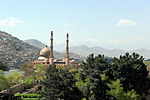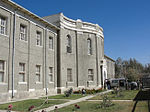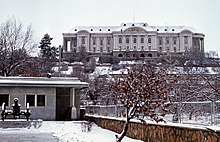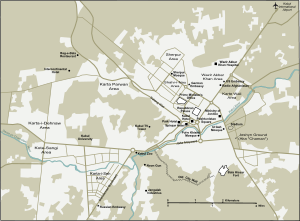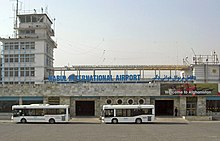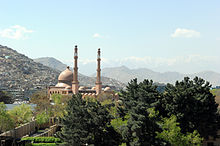Kabul
From Wikipedia, the free encyclopedia
For other places with the same name, see Kabul (disambiguation).
| Kabul کابل | |
|---|---|
| — City — | |
Location in Afghanistan | |
| Coordinates: 34°31′59″N 69°09′58″E / 34.53306°N 69.16611°ECoordinates: 34°31′59″N 69°09′58″E / 34.53306°N 69.16611°E | |
| Country | |
| Province | Kabul |
| No. of sectors | 18 |
| Government | |
| - Mayor | Muhammad Yunus Nawandish |
| Area | |
| - City | 275 km2 (106.2 sq mi) |
| - Metro | 425 km2 (164.1 sq mi) |
| Elevation | 1,790 m (5,873 ft) |
| Population (2008) | |
| - Metro | 2,850,000 |
| [1] | |
| Time zone | Afghanistan Standard Time (UTC+4:30) |
It is an economic and cultural centre, situated 5,900 ft (1,800 m) above sea level in a narrow valley, wedged between the Hindu Kush mountains along the Kabul River. The city is linked with Kandahar, Herat and Mazar-e Sharif via a circular highway that stretches across the country. It is also the start of the main road to Jalalabad and further to Peshawar, Pakistan.
Kabul's main products include fresh and dried fruit, nuts, Afghan rugs, leather and sheep skin products, domestic clothes and furniture, and antique replicas, but the wars since 1978 have limited the economic productivity of the city. Economic productivity has improved since the establishment of the Karzai administration in late 2001.[3]
Kabul is over 5000 years old; many empires have long fought over the city for its strategic location along the trade routes of South and Central Asia.[4] From 1504 to 1526, Kabul served as the original capital of Babur, builder of the Mughal Empire. It remained under the Delhi Sultanate until 1738, when Nader Shah and his Afsharid forces invaded the Mughal Empire.[5] After the death of Nader Shah Afsharid in 1747, the city fell to Ahmad Shah Durrani, who quickly added it to his new Afghan Empire.[6] In 1776, Timur Shah Durrani made it the capital of the modern state of Afghanistan. Since the 1980s Soviet war in Afghanistan, the city has been a target of militant groups. It is currently being re-developed[7] but attacks by Taliban and other militants are slowing down the reconstruction process.
Contents |
[edit] History
[edit] Antiquity
The Kabul valley is believed to be over 5,000-8000 years old. The word "Kubhā" is mentioned in Rigveda and the Avesta around 3000 BC, which appears to refer to the Kabul River.[8] The Rigveda praises it as an ideal city, a vision of paradise set in the mountains.[9] Others suggest that the city may have been established between 2000 BC and 1500 BC.[10] The area in which the Kabul valley sat in was part of the Median Empire before being conquered by the Persian Achaemenid Empire. There is a reference to a settlement called Kabura by the rulers of the Achaemenid Empire (Darius, Darius II and Darius III of Persia), which may be the basis for the future use of the name Kabura (Κάβουρα) by Ptolemy.[8] It became a centre of Zoroastrianism followed by Buddhism and Hinduism later. Alexander the Great explored the Kabul valley after his conquest of the Achaemenid Empire in 330 BC but no record has been made of Kabul, which may have been only a small town and not worth writing about.[4] The region became part of the Seleucid Empire before falling to the Indian Maurya Empire.The Greco-Bactrians captured Kabul from the Mauryans in the early 2nd century BC, then lost the city to their subordinates in the Indo-Greek Kingdom around the mid-2nd century BC. The Bactrians founded the town of Paropamisadae near Kabul, but it was later ceded to the Mauryans in the 1st century BC. Indo-Scythians expelled the Indo-Greeks by the mid 1st century BC, but lost the city to the Kushan Empire about 100 years later.[11]Alexander took these away from the Aryans and established settlements of his own, but Seleucus Nicator gave them to Sandrocottus (Chandragupta), upon terms of intermarriage and of receiving in exchange 500 elephants.[4]—Strabo, 64 BC–24 AD
According to historians the Sanskrit name of Kabul is believed to be Kamboja (Kamboj).[12][13] It is mentioned as Kophes or Kophene in some classical writings. Hsuan Tsang refers to the name as Kaofu[14] in the 7th century AD, which is the appellation of one of the five tribes of the Yuezhi who had migrated from across the Hindu Kush into the Kabul valley around the beginning of the Christian era.[15] It was conquered by Kushan Emperor Kujula Kadphises in about 45 AD and remained Kushan territory until at least the 3rd century AD.[16][17] The Kushan were Indo-European-speaking Tocharians from the Tarim Basin.[18]
Around 230 AD, the Kushans were defeated by the Sassanid Empire and replaced by Sassanid vassals known as the Indo-Sassanids. During the Sassanian period, the city was referred to as "Kapul" in Pahlavi scripts.[8] In 420 AD the Indo-Sassanids were driven out of Afghanistan by the Xionite tribe known as the Kidarites, who were then replaced in the 460s by the Hephthalites. It became part of the surviving Turk Shahi Kingdom of Kapisa, also known as Kabul-Shahan.[19] According to Táríkhu-l Hind by Al-Biruni, Kabul was governed by princes of Turkic lineage who's rule lasted for 60 generations.
The Kabul Turks and Hindus built a huge defensive wall around the city to protect it from future invaders. This wall has survived until today and is also considered a historical site.Kábul was formerly governed by princes of Turk lineage. It is said that they were originally from Tibet. The first of them was named Barhtigín, * * * * and the kingdom continued with his children for sixty generations. * * * * * The last of them was a Katormán, and his minister was Kalar, a Bráhman. This minister was favoured by fortune, and he found in the earth treasures which augmented his power. Fortune at the same time turned her back upon his master. The Katormán's thoughts and actions were evil, so that many complaints reached the minister, who loaded him with chains, and imprisoned him for his correction. In the end the minister yielded to the temptation of becoming sole master, and he had wealth sufficient to remove all obstacles. So he established himself on the throne. After him reigned the Bráhman(s) Samand, then Kamlúa, then Bhím, then Jaipál, then Anandpál, then Narda-janpál, who was killed in A.H. 412. His son, Bhímpál, succeeded him, after the lapse of five years, and under him the sovereignty of Hind became extinct, and no descendant remained to light a fire on the hearth. These princes, notwithstanding the extent of their dominions, were endowed with excellent qualities, faithful to their engagements, and gracious towards their inferiors...[19]—Abu Rayhan Biruni, 978-1048
[edit] Islamic conquest to the Mongol invasion
Further information: Islamic conquest of Afghanistan
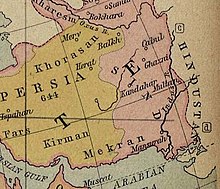
The Islamic conquest of Afghanistan began from Herat, which was one of the important cities of Khorasan, and made its way to Kabul in the late 7th century.
Over the centuries to come, the city was successively controlled by the Samanids, Ghaznavids, Ghurids, and Kartids. In the 13th century the Mongol horde passed through and caused massive destruction in the area. Report of a massacre in the close by Bamiyan is recorded around this period, where the entire population of the valley was annihilated by the Mongol troops as a revenge for the death of Genghis Khan's grandson. One of Genghis Khan's grandson is thought to be named Kabul.[22] During the Mongol invasion, many natives of Afghanistan fled to India where some established dynasties in Delhi."Kábul has a castle celebrated for its strength, accessible only by one road. In it there are Musulmáns, and it has a town, in which are infidels from Hind."[21]—Istahkrí, 921
Following the era of the Khilji dynasty in 1333, a famous Moroccan travelling scholar, Ibn Battuta, was visiting Kabul and he mentioned that Kabul was inhabited by Persian-speaking Afghan tribes:
We travelled on to Kabul, formerly a vast town, the site of which is now occupied by a village inhabited by a tribe of Persians called Afghans. They hold mountains and defiles and possess considerable strength, and are mostly highwaymen. Their principle mountain is called Kuh Sulayman.[23]—Ibn Battuta, 1304–1369
[edit] Timurid and Mughal era
Further information: Timurid dynasty and Mughal Empire
In the 14th century, Kabul rose again as a trading centre under the kingdom of Timur (Tamerlane). In 1504, the city fell to Babur from the north and made into his headquarters, which became one of the principal cities of his later Mughal Empire. In 1525, Babur described kabul (Greater Kabul) as a dominant Tajik region with many other minorities, in his memoirs titled Baburnama that:
Mirza Muhammad Haidar Dughlat, a poet from India who visited at the time wrote: "Dine and drink in Kabul: it is mountain, desert, city, river and all else." It was from here that Babur began his 1526 conquest of India. Babur wished to be buried in Kabul, a city he had always loved, but at first he was buried in Agra, India. Roughly nine years later his remains were dug back up and re-buried at Bagh-e Babur (Babur Gardens) in Kabul by Sher Shah Suri on orders by Babur's wife. The inscription on his tomb contains Persian words penned which state: "اگر پردیس روی زمین است همین است و همین است و همین است" (If there is a paradise on earth, it is this, it is this, it is this!)[25]In the country of Kābul there are many and various tribes. Its valleys and plains are inhabited by Tūrks, Aimāks, and Arabs. In the city and the greater part of the villages, the population consists of Tājiks (called "Sarts" by Babur). Many other of the villages and districts are occupied by Pashāis, Parāchis, Tājiks, Berekis, and Afghans. In the hill-country to the west, reside the Hazāras and Nukderis. Among the Hazāra and Nukderi tribes, there are some who speak the Moghul language. In the hill-country to the north-east lies Kaferistān, such as Kattor and Gebrek. To the south is Afghanistān... There are eleven or twelve different languages spoken in Kābul: Arabic, Persian, Tūrki, Moghuli, Hindi, Afghani, Pashāi, Parāchi, Geberi, Bereki, and Lamghāni...[24]—Babur, 1525
The city was often contested by Babur's sons, especially Kamran Mirza and Humayun. Humayun was chased away from Hindustan by Sher Shah Suri but was able to return in November 1545 with Persian aid, where he is believed to have taken Kabul without any blood-spills. Kamran managed to retake Kabul twice but he remained a hated figure to the residents of the city, as his periods of rule involved atrocities against large numbers of them. Following his third and final ejection from Kabul in 1552, Kamran fled and was captured in Punjab by a general of Islam Shah Suri, ruler of the Sur Empire in northern India. Kamran was handed over to Humayun in Kabul, who made him blind.
[edit] Afghan nation-state
[edit] Durrani Empire
Further information: Durrani Empire

Shah Shuja, the last Durrani King, sitting at his court inside the Bala Hissar before it was destroyed by the British Army
In 1826, the kingdom was claimed by Dost Mohammad Khan and taken from him by the British Indian Army in 1839, who installed the unpopular Shah Shuja. An 1841 local uprising resulted in the loss of the British mission and the subsequent Massacre of Elphinstone's Army of approximately 16,000 foreign forces, which included civilians and camp followers on their retreat from Kabul to Jalalabad. In 1842 the British returned, plundering Bala Hissar in revenge before fleeing back to British India (now Pakistan). Dost Mohammed returned to the throne.
The British and Indian forces invaded in 1878 as Kabul was under Sher Ali Khan's rule, but the British residents were again massacred. The invaders again came in 1879 under General Roberts, partially destroying Bala Hissar before retreating to British India (Pakistan). Amir Abdur Rahman Khan was left in control of the country.
In the early 20th century King Amanullah Khan rose to power. His reforms included electricity for the city and schooling for girls. He drove a Rolls-Royce, and lived in the famous Darul Aman Palace. In 1919, after the Third Anglo-Afghan War, Amanullah announced Afghanistan's independence from foreign affairs at Eidgah Mosque. In 1929 Ammanullah Khan left Kabul due to a local uprising orchestrated by Habibullah Kalakani and Ammanullah's brother, Nader Khan, took control over the nation. King Nader Khan was assassinated in 1933 and the throne was left to his 19-year-old son, Zahir Shah, who became the long lasting King of Afghanistan.
During this period between the two World Wars France and Germany worked to help develop the country in both the technical and educational spheres. Both countries maintained high schools and lycees in the capital and provided an education for the children of elite families.[26] Kabul University opened in 1932 and soon was linked to both European and American universities, as well as universities in other Muslim countries in the field of Islamic studies.[27] By the 1960s the majority of instructors at the university had degrees from Western universities.[27]
When Zahir Shah took power in 1933 Kabul had the only 6 miles of rail in the country, few internal telegraph or phone lines and few roads. He turned to the Japanese, Germans and Italians for help developing a modern network of communications and roads.[28] A radio tower built by the Germans in 1937 in Kabul allowed instant communication with outlying villages.[29] A national bank and state cartels were organized to allow for economic modernization.[30] Textile mills, power plants and carpet and furniture factories were also built in Kabul, providing much needed manufacturing and infrastructure.[30]
In 1955, the Soviet Union forwarded $100 million in credit to Afghanistan, which financed public transportation, airports, a cement factory, mechanized bakery, a five-lane highway from Kabul to the Soviet border and dams.[31]
In the 1960s, Kabul developed a cosmopolitan mood. The first Marks & Spencer store in Central Asia was built there. Kabul Zoo was inaugurated in 1967, which was maintained with the help of visiting German zoologists. Many foreigners began flocking to Kabul with the increase in global air travels around that time. The nation's tourism industry was starting to pick up rapidly for the first time. Kabul experimented with liberalization, dropping laws requiring women to wear the burka, restrictions on speech and assembly loosened which led to student politics in the capital.[32] Socialist, Maoist and liberal factions demonstrated daily in Kabul while more traditional Islamic leaders spoke out against the failure to aid the Afghan countryside.[32] A 1969 a religious uprising at the Pul-e Khishti Mosque protested the Soviet Union's increasing influence over Afghan politics and religion. This protest ended in the arrest of many of its organizers, including Mawlana Faizani, a popular Islamic scholar. In the early 1970s Radio Kabul began to broadcast in other languages besides Pashtun which helped to unify those minorities that often felt marginalized, however this was put to a stop with Daoud's revolution in 1973.[33]
In July 1973, Zahir Shah was ousted in a nonviolent coup and Kabul became the capital of a republic under Mohammed Daoud Khan, the new President. Daoud's revolution was actually supported by the communist party in the city, the PDP. The support of the PDP helped to prevent a violent clash in his coup in 1973. He named himself President of this new democracy and planned to institute reforms. Daoud was the long standing prime minister, and while he instituted a republic he had Soviet leanings in terms of political allies.[34] He had welcomed Soviet military aid and advisors in 1956.[35] Conversely, some of the people of Kabul who lived under King Zahir Shah describe the period before the April 1978 Saur Revolution as a sort of golden age. All the different ethnic groups or tribes of Afghanistan lived together harmoniously and thought of themselves first and foremost as Afghans. They intermarried and mixed socially.[9]
In the later years of his leadership, Daoud began to shift favour from the Soviet Union to Islamic nations, expressing admiration for their wealth from oil and expecting economic aid from them to quickly surpass that of the Soviet Union.[36] The slow speed of reforms however frustrated both the Western educated elite and the Russian trained army officers.[37] Daoud forced many communists out of his government, which unified the various communist factions within the city.[37]
[edit] Communist revolution and Soviet invasion
Further information: Soviet war in Afghanistan and Civil war in Afghanistan
On April 27, 1978, in the so-called Saur revolution, the People's Democratic Party of Afghanistan (PDPA), seized power in a bloody military coup killing Daoud and his family along with many of his supporters.[37] The new communist regime moved quickly to institute reforms. Private businesses were nationalized in the Soviet manner.[38] Education was modified into the Soviet model, with lessons focusing on teaching Russian, Leninism-Marxism and learning of other countries belonging to the Soviet bloc.[38] Rural guerrillas and disaffected army deserters took up arms in the name of Islam, due to the communist regime's increasing rejection of it.[38] This rebellion would eventually lead to the invasion of Afghanistan by Russian forces.[39]
After the Soviet invasion of Afghanistan, on December 24, 1979, the Red Army occupied the capital. They turned the city into their command centre during the 10-year conflict between the Soviet-allied government and the Mujahideen rebels. Kabul remained relatively calm during that period as fighting was mostly in the countryside and in other major cities. The American Embassy in Kabul closed on January 30, 1989.
[edit] Foreign interference and war in Kabul
Main articles: Civil war in Afghanistan (1989-1992), Civil war in Afghanistan (1992-1996), and Civil war in Afghanistan (1996-2001)
After the fall of the communist Najibullah-regime in 1992, the Afghan political parties agreed on a peace and power-sharing agreement (the Peshawar Accords). The Peshawar Accords created the Islamic State of Afghanistan and appointed an interim government for a transitional period. Human Rights Watch writes:- "The sovereignty of Afghanistan was vested formally in "The Islamic State of Afghanistan", an entity created in April 1992, after the fall of the Soviet-backed Najibullah government. ... With the exception of Gulbuddin Hekmatyar's Hezb-e Islami, all of the parties ... were ostensibly unified under this government in April 1992. ... Hekmatyar's Hezb-e Islami, for its part, refused to recognize the government for most of the period discussed in this report and launched attacks against government forces and Kabul generally. ... Hekmatyar continued to refuse to join the government. Hekmatyar's Hezb-e Islami forces increased their rocket and shell attacks on the city. Shells and rockets fell everywhere."[40]
- "Pakistan was keen to gear up for a breakthrough in Central Asia. ... Islamabad could not possibly expect the new Islamic government leaders, especially [Ahmad Shah] Massoud (who had always maintained his independence from Pakistan), to subordinate their own nationalist objectives in order to help Pakistan realize its regional ambitions. ... Had it not been for the ISI's logistic support and supply of a large number of rockets, Hekmatyar's forces would not have been able to target and destroy half of Kabul."[42]
- "[O]utside forces saw instability in Afghanistan as an opportunity to press their own security and political agendas."[44]
- "Rare ceasefires, usually negotiated by representatives of Ahmad Shah Massoud, Sibghatullah Mojaddedi or Burhanuddin Rabbani (the interim government), or officials from the International Committee of the Red Cross (ICRC), commonly collapsed within days," writes Human Rights Watch.[40]
The Taliban started shelling Kabul in early 1995 but were defeated by forces of the Islamic State government under Ahmad Shah Massoud.[48] see video Amnesty International, referring to the Taliban offensive, wrote in a 1995 report:
The Taliban's early victories in 1994 were followed by a series of defeats that resulted in heavy losses.[51] Pakistan provided strong support to the Taliban.[42][52] Many analysts like Amin Saikal describe the Taliban as developing into a proxy force for Pakistan's regional interests which the Taliban decline.[42]"This is the first time in several months that Kabul civilians have become the targets of rocket attacks and shelling aimed at residential areas in the city."[48]
[edit] Taliban Emirate vs United Front

Afghanistan's National Hero Ahmad Shah Massoud (right) and Pashtun anti-Taliban leader Haji Abdul Qadir (left)
After the fall of Kabul to the Taliban on September 27, 1996,[55] The Taliban, without any real court or hearing, cut people's hands or arms off when accused of theft. Taliban hid-squads from the infamous "Ministry for Promotion of Virtue and Prevention of Vice" watched the streets conducting arbitrary brutal and public beatings of people when they saw what they considered as unislamic behavior.[54] The Taliban also tortured ex-President Najibullah and his brother to death and lynched their dead corpses publicly."To PHR’s knowledge, no other regime in the world has methodically and violently forced half of its population into virtual house arrest, prohibiting them on pain of physical punishment."[54]
Ahmad Shah Massoud withdrew his forces from Kabul to the northern regions of Afghanistan where he created the United Front (Northern Alliance) against the Taliban that were preparing offensives against the remaining areas under the control of Massoud and those under the control of regional leaders. see video According to a 55-page report by the United Nations, the Taliban, while trying to consolidate control over northern and western Afghanistan, committed systematic massacres against civilians.[56][57] U.N. officials stated that there had been "15 massacres" between 1996 and 2001.[56][57] They also said, that "[t]hese have been highly systematic and they all lead back to the [Taliban] Ministry of Defense or to Mullah Omar himself."[56][57] The Taliban especially targeted people of Shia religious or Hazara ethnic background.[56][57] Upon taking Mazar-i-Sharif in 1998, about 4,000 civilians were executed by the Taliban and many more reported tortured.[58][59] Many civilians fled to the area of Ahmad Shah Massoud. The National Geographic concluded: "The only thing standing in the way of future Taliban massacres is Ahmad Shah Massoud."[60]
Pakistani President Pervez Musharraf – then as Chief of Army Staff – was responsible for sending thousands of Pakistanis to fight alongside the Taliban and Bin Laden against the United Front.[52][60][61][50] In total there were believed to be 28,000 Pakistani nationals fighting inside Afghanistan.[50] From 1996 to 2001 the Al Qaeda of Osama Bin Laden and Ayman al-Zawahiri furthermore became a state within the Taliban state.[62] Bin Laden sent Arab recruits to join the fight against the United Front.[63][62] Of roughly 45,000 Pakistani, Taliban and Al Qaeda soldiers fighting against the forces of Massoud only 14,000 were Afghan.[64][50]
Kabul remained under Taliban control until November 2001.
[edit] Recent history (2001–present)
Further information: War in Afghanistan (2001–present)
In October 2001, the United States armed forces assisted by British Armed Forces provided massive air support to United Front (Northern Alliance) ground forces during Operation Enduring Freedom. The Taliban abandoned Kabul and the United Front came to take control of the city. In late December 2001 Kabul became the capital of the Afghan Transitional Administration, which transformed to the present Government of Afghanistan that is led by President Hamid Karzai. In early 2002 a NATO-led International Security Assistance Force (ISAF) was deployed in Kabul and from there they began taking over other parts of the country. Since the beginning of 2003, the city of Kabul has been slowly developing with the help of foreign investment. Its population has grown from about 500,000 in 2001 to over 3 million now. It is also the scene of occasional deadly suicide bombings and explosions carried out by the Haqqani network, Hezb-i Islami, Taliban and anti-Afghanistan elements. Since 2008 the newly trained Afghan National Police (ANP) and the Afghan National Army (ANA) are in charge of security in the area.[edit] Climate
Kabul has a semi-arid climate (Köppen climate classification BSk) with precipitation concentrated in the winter (sometimes falling as snow) and spring months. Summer has very low humidity, providing relief from the heat. Autumn features warm nights and sharply cooler evenings. Winters are cold, with a January daily average of −2.3 °C (27.9 °F). Spring is the wettest time of the year, though temperatures are generally amiable. Sunny conditions dominate year-round. The annual mean temperature is 12.1 °C (53.8 °F).| Climate data for Kabul (1956–1983) | |||||||||||||
|---|---|---|---|---|---|---|---|---|---|---|---|---|---|
| Month | Jan | Feb | Mar | Apr | May | Jun | Jul | Aug | Sep | Oct | Nov | Dec | Year |
| Average high °C (°F) | 4.5 (40.1) | 5.5 (41.9) | 12.5 (54.5) | 19.2 (66.6) | 24.4 (75.9) | 30.2 (86.4) | 32.1 (89.8) | 32.0 (89.6) | 28.5 (83.3) | 22.4 (72.3) | 15.0 (59) | 8.3 (46.9) | 19.6 (67.3) |
| Average low °C (°F) | −7.1 (19.2) | −5.7 (21.7) | 0.7 (33.3) | 6.0 (42.8) | 8.8 (47.8) | 12.4 (54.3) | 15.3 (59.5) | 14.3 (57.7) | 9.4 (48.9) | 3.9 (39) | −1.2 (29.8) | −4.7 (23.5) | 4.3 (39.7) |
| Precipitation mm (inches) | 34.3 (1.35) | 60.1 (2.366) | 67.9 (2.673) | 71.9 (2.831) | 23.4 (0.921) | 1.0 (0.039) | 6.2 (0.244) | 1.6 (0.063) | 1.7 (0.067) | 3.7 (0.146) | 18.6 (0.732) | 21.6 (0.85) | 312.0 (12.283) |
| Avg. precipitation days | 2 | 3 | 10 | 11 | 8 | 1 | 2 | 1 | 1 | 2 | 4 | 3 | 48 |
| Sunshine hours | 176.7 | 180.8 | 204.6 | 234.0 | 310.0 | 354.0 | 356.5 | 341.0 | 303.0 | 282.1 | 252.0 | 182.9 | 3,177.6 |
| Source: HKO [65] | |||||||||||||
[edit] Administration
The city of Kabul is one of the 15 districts of Kabul Province, which is further divided into 18 city districts or sectors. Each city district covers several neighborhoods. The number of districts or sectors in Kabul increased from 11 to 18 in 2005.The Mayor of the city is selected by the President of Afghanistan, who engages in planning and environmental work. The police belong to the Afghan Ministry of Interior and are arranged by city districts. The Chief of Police is selected by the Minister of Interior and is responsible for law enforcement and security of the city.
[edit] Areas of the city
Below are some of Kabul's neighborhoods listed:
|
[edit] Demographics
Further information: Demography of Afghanistan and Afghan refugees
The population of Kabul has fluctuated since the early 1980s to the present period. It was believed to be around 500,000 in 2001 but since then many Afghan expats began returning from Pakistan and Iran where they had taken refuge from the wars.[67] The Kabul metropolitan area has a population of about 2.8 million inhabitants these days.[1] The wider Kabul province, which also includes rural areas, has a population of around 3.5 million people,[1] while the Kabul city's population makes almost 80 percent of the total provincial population.[68]
The population of the city reflects the general multi-ethnic, multi-cultural, and multi-lingual characteristics of Afghanistan. There is no official government report on the exact ethnic make-over but a map appeared in the November 2003 issue of the National Geographic magazine showing Tajiks 45%, Hazaras 25%, Pashtuns 25%, Uzbek 2%, Baloch 1%, Turkmen 1%, and Hindu 1%.[69] Pashto and Dari (Persian) are the most widely used languages in the area[68][70], although Dari serves as the lingua franca and many in the city are bilingual.
Nearly all the people of Kabul are Muslim, which includes the majority Sunnis and minority Shias. A small number of Sikhs, Hindus, and Christians[citation needed] are also found in the city. For example, Bollywood actress Celina Jaitley is Hindu who was born in Kabul. There is only one Jew in Kabul, whose name is Zablon Simintov.
[edit] Transport
Further information: Transport in Afghanistan
Kabul International Airport, located 25 kilometres (16 mi) from the centre of Kabul, is the country's main airport. It is a hub to Ariana Afghan Airlines, which is the national airlines carrier of Afghanistan. Kam Air, Pamir Airways, and Safi Airways also have their headquarters in Kabul. Airlines from nearby nations such as Pakistan, Iran, India, and several others also make stops at Kabul Airport. A new international terminal was built by the government of Japan and began operation in 2008. The new terminal is the first of three terminals to be opened so far. The other two will open once air traffic to the city increases. Passengers coming from most foreign nations use mostly Dubai for flights to Kabul. Kabul Airport also has a military air base which serves as the main airport for Afghan National Air Corps. NATO also uses the Kabul Airport, but most military traffic is based at Bagram Air Base, just north of Kabul. The Afghan National Army and Afghan National Police are in charge of the airport security. For the year of 2009, the militaries of Hungary and Poland were the operators of the entire airport, paying for the upkeep and protection of the facility, under command of NATO.
Bus service to most major cities of the country is available in Kabul although they are not as safe, especially for foreigners. The city's public buses (Milli Bus / "National Bus") take commuters on daily routes to many destinations. The service currently has approximately 800 buses but is gradually expanding and upgrading with more buses being added. The Kabul bus system has recently discovered a new source of revenue in whole-bus advertising from MTN similar to "bus wrap" advertising on public transit in more developed nations. There is also an express bus that runs from the city centre to Kabul International Airport for Safi Airways passengers. There are also yellow taxicabs just about anywhere in and around the city.
Private vehicles are on the rise in Kabul, with Toyota, Nissan, and other dealerships in the city. People are buying new cars as the roads and highways are being improved. Most drivers in Kabul prefer owning a Toyota Corolla, one of Afghanistan's most popular car. It has even been reported that up to 90% of cars in Kabul are Corollas.[71][72] With the exception of motorcycles many vehicles in the city operate on LPG. Gas stations are mainly private-owned but the fuel comes from Iran. Bikes on the road are a common sight in the city.
[edit] Communications
Further information: Communications in Afghanistan
GSM/GPRS mobile phone services in the city are provided by Afghan Wireless, Etisalat, Roshan and MTN. In November 2006, the Afghan Ministry of Communications signed a US 64.5 million dollar agreement with a company (ZTE Corporation) on the establishment of a countrywide fibre optical cable network. This will improve telephone, internet, television and radio broadcast services not just in Kabul but throughout the country.[73] Internet was introduced in the city in 2002 and has been expanding rapidly.There are a number of post offices throughout the city. Package delivery services like FedEx, TNT N.V., and DHL are also available.
The city has many local-language radio stations, including Pashto and Dari, as well as some programs in the English language. The Afghan government has become increasingly intolerant of Indian channels and the un-Islamic culture they bring, and has threatened to ban them.
[edit] Education
Further information: Education in Afghanistan and List of schools in Afghanistan
Public and private schools in the city have reopened since 2002 after they were shut down or destroyed during fighting in the 1980s to the late 1990s. Boys and girls are strongly encouraged to attend school under the Karzai administration but many more schools are needed not only in Kabul but throughout the country. The Afghan Ministry of Education has plans to build more schools in the coming years so that education is provided to all citizens of the country. The most well known high schools in Kabul include:- Habibia High School, a British-Afghan school founded in 1903 by King Habibullah Khan.
- Lycée Esteqlal, a Franco-Afghan school founded in 1922.
- Amani High School, a German-Afghan school for boys founded in 1924.
- Aisha-i-Durani School, a German-Afghan school for girls.
[edit] Universities in Kabul
Further information: List of universities in Afghanistan
- Kabul University
- Kabul Medical University
- Polytechnical University of Kabul (Kabul Polytechnic)
- American University of Afghanistan
- Higher Education Institute of Karwan
- Rana Institute of Higher Education
- Bakhtar Institute of Higher Education
- Dawat University
- National Military Academy of Afghanistan
[edit] Places of interest
The old part of Kabul is filled with bazaars nestled along its narrow, crooked streets. Cultural sites include the Afghan National Museum, notably displaying an impressive statue of Surya excavated at Khair Khana, the ruined Darul Aman Palace, the Mausoleum of Emperor Babur and Chehlstoon Park, the Minar-i-Istiqlal (Column of Independence) built in 1919 after the Third Afghan War, the mausoleum of Timur Shah Durrani, and the imposing Id Gah Mosque (founded 1893). Bala Hissar is a fort destroyed by the British in 1879, in retaliation for the death of their envoy, now restored as a military college. The Minaret of Chakari, destroyed in 1998, had Buddhist swastika and both Mahayana and Theravada qualities.Other places of interest include Kabul City Center, which is Kabul's first shopping mall, the shops around Flower Street and Chicken Street, Wazir Akbar Khan district, Babur Gardens, Kabul Golf Club, Kabul Zoo, Shah Do Shamshera and other famous Mosques, the Afghan National Gallery, Afghan National Archive, Afghan Royal Family Mausoleum, the OMAR Mine Museum, Bibi Mahroo Hill, Kabul Cemetery, and Paghman Gardens.
Tappe-i-Maranjan is a nearby hill where Buddhist statues and Graeco-Bactrian coins from the 2nd century BC have been found. Outside the city proper is a citadel and the royal palace. Paghman and Jalalabad are interesting valleys north and east of the city.
- Airports
- Parks
- Bagh-e Babur (Babur Gardens)
- Bāghi Bālā Park
- Lake Qargha
- Zarnegar Park
- Shar-e Naw Park
- Bagh-e Zanana
- Chaman-e-Hozori
- Bebi Mahroo Park
- Mosques
- Mausoleums
- Mausoleum of Tamim Ansar
- Mausoleum of Timur Shah Durrani
- Mausoleum of Abdur Rahman Khan
- Mausoleum of Zahir Shah and Nadir Shah
- Museums
- National Museum of Afghanistan
- National Gallery of Afghanistan
- Negaristani Milli
- Hotels
- Marriott (under construction)
- Serena Hotel
- Inter-Continental
- Safi Landmark Hotel[74]
- Golden Star Hotel[75]
- Heetal Plaza Hotel[76]
- Parwan Hotel[citation needed]
[edit] Reconstruction and developments

The plan for Kabul's nine billion dollar future modern urban development project, the City of Light Development.
A small sized indoor shopping mall (Kabul City Center) with the 4-star Safi Landmark Hotel on the top six floors opened in 2005. The Aga Khan Development Network (AKDN) opened a 5-star Serena Hotel in the same year, while the landmark Inter-Continental has been refurbished. The AKDN was also involved in the restoration work of the Bagh-e Babur (Babur Gardens). Another 5-star Marriott Hotel is under construction next to the U.S. Embassy. A number of high rise buildings are being planned and constructed across Kabul, as part of the attempt to modernize the city.[77]
An initial concept design called the City of Light Development, envisioned by Dr. Hisham N. Ashkouri, for the development and the implementation of a privately based investment enterprise has been proposed for multi-function commercial, historic and cultural development within the limits of the Old City of Kabul, along the southern side of the Kabul River and along Jade Meywand Avenue,[78] revitalizing some of the most commercial and historic districts in the City. Also incorporated in the design is a new complex for the National Museum of Afghanistan. A Memorandum of understanding has been signed between Dr. Ashkouri and Said Tayeb Jawad to undertake the project and to develop it for actual implementation over the next 20 years. Dr. Ashkouri has also presented the plan to President Karzai and has received a letter of support from the president and the Minister of Urban Development.
About 4 miles (6 km) from downtown Kabul, in Bagrami, a 22-acre (9 ha) wide industrial complex has completed with modern facilities, which will allow companies to operate businesses there. The park has professional management for the daily maintenance of public roads, internal streets, common areas, parking areas, 24 hours perimeter security, access control for vehicles and persons. Another phase with additional 27 acres (11 ha) of land will be added immediately proceeding the first phase.[79] A $25 million Coca-Cola bottling plant was opened in 2006. President Hamid Karzai formally opened the facility in an attempt to attract more foreign investment in the city.
In late 2007 the government announced that all the residential houses situated on mountains would be removed within a year so that trees and other plants can be grown on the hills. The plan calls for a greener city and to provide residents with a more suitable place to live, on a flat surface. Once implemented it will provide water supply and electricity to each house. All the city roads will also be paved under the plan, which is to solve transportation problems.[80]
[edit] NGOs
Numerous non-governmental organizations (NGOs), both national and international, are based in Kabul, conducting various activities to assist development in Afghanistan and provide humanitarian relief to the many victims which 30 years of war have produced.Afghanistan Information Management Services (AIMS) provides software development, capacity development, information management, and project management services to the Afghan Government and other NGOs, thereby supporting their on-the-ground activities.
The We Are the Future (WAF) Center is a child care centre whose aim is to give children a chance to live their childhoods and develop a sense of hope. The centre is managed under the direction of the mayor's office and the international NGO. Glocal Forum serves as the fundraiser, program planner and coordinator for the WAF centre. Launched in 2004, the program is the result of a strategic partnership between the Glocal Forum, the Quincy Jones Listen Up Foundation and Mr. Hani Masri, with the support of the World Bank, UN agencies and major companies.

